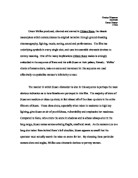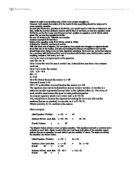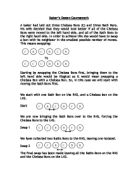Consecutive Numbers Investigation
James Lucas CONSECUTIVE NUMBERS Problem 1 Gap 1 Take three consecutive numbers; square the middle number, multiply the first by the third number. What do you notice? 2, 3, 4 are consecutive numbers they follow on from each other. The next number is one more than. 2, 3, 4 32 = 3*3 = 9 2*4 = 8 Difference 1 The numbers above are consecutive numbers; the difference between them is one. 8, 19, 20 92 = 19*19 = 361 8*20 = 360 Difference 1 97, 98, 99 982 = 98*98 = 9604 97*99 = 9603 Difference 1 17, 118, 119 182 = 118*118 = 13924 17*119 = 13923 Difference 1 It appears that it will work every time. I have tried it four times and it works all right so far. I will now try decimals. .2, 2.2, 3.2 2.22 = 2.2*2.2 = 4.84 .2*3.2 = 3.84 Difference 1 0.9, 11.9, 12.9 1.92 = 11.9*11.9 = 141.61 0.9*12.9 = 140.61 Difference 1 It would appear that it works using decimals. I will now try negative numbers. -8, -7, -6 -72 = -7*-7 = 49 -8*-6 = 48 Difference 1 -5, -4, -3 -42 = -4*-4 = +16 -5*-3 = +15 Difference 1 I have found out that it also works with negative numbers. I will now hope to show that it works with algebra. X, X+1, X+2 st *3rd = X*(x+2) = X2=2X 2nd squared = (X+1)2 = (X+1)(X+1) (X +1)(X+1) = X2 + 1 + 1X + 1X = X2 + 2X + 1 The only difference is +1. It shows that the difference will always be 1. I am now going to see what happens if I make
Orson Welles in Citizen Kane.
Kaeley Wiseman 0223360 Karen Kasner TY05 Orson Welles produced, directed and starred in Citizen Kane, the classic masterpiece which communicates its original narrative through ground-breaking cinematography, lighting, music, setting, sound and performances. The film has underlying symbols in every single shot, and uses innumerable cinematic devices to convey meaning. One of the many implications Citizen Kane makes is strongly embodied in the sequence of Kane and his wife Susan at their palace, Xanadu. Welles' choice of camera shots, mise-en-scene and movement in this sequence are used effectively to symbolize women's inferiority to men. The manner in which Susan Alexander is shot in this sequence is perhaps the most obvious indication as to how females are portrayed in this film. The majority of shots of Susan are medium or close-up shots; in fact almost all of the close-up shots in the entire film are of Susan. These close shots, especially when taken in moderate to high key lighting, give Susan an air of youthfulness, vulnerability and emphasize her meekness. Compared to Kane, who enters the scene in shadows and is almost always shot in the long-range, Susan comes across as being fragile, small and weak. As the camera cuts to a long shot taken from behind Kane's left shoulder, Susan appears so small that the spectator must actually search the mise-en-scene for
Algebra Basics
Algebra is quite an interesting topic, which many people struggle on, However I will explain the basics of it, the basics is that everything should be balanced in every equation question for example if there is a question of 2x+8=12x, you would need to make the xs balance in one side, whilst the number (being 8, here) is with its kind of numbers, so now the equation reads 8=12x-2x, as the 2x moves over it becomes from positive to negative, so it is 12x-2x which gives 10x, so now the equation is 8=10x So now 10 divide by 8= 10/8=5/4 as a fraction. Another example is 6+3x=12x-4 Balance the equation so its 6+4=12x-3x, which is 10=9x 9 divided by 10=9/10, and leave it as that. With this basic rule of algebra, it is compulsory that people who struggle on algebra should know this rule as the basics, and also by knowing the balance of equations such as this should help when doing more complex algebraic equations. So to sum up, remember balance the x numbers with its kind and the normal numbers with its kind, note, that the letter could be anything, not just x, but even y or m etc. I will give more examples such as the question, 2X +9= 4X -8 Now I allow the time for you to work it out, it should take less then a two minutes work out. Now I will reveal the answer 2X - 4X= -8-9 8X=-17 X=17/8 Now for Mixed fraction the answer is 2 1/8 Because 8 times 2=16 6+1=17 so
Chessboard coursework
How many squares on a chess board Introduction This is my first piece of mathematics coursework. In this project I will be finding out how many squares on a 8x8 chess board. In this project I will be including labelled drawings, clear enough to allow a non mathematician to follow, clearly written work, initial drawings of each of my steps and a finished formula justified. Finally an extension on my board making it rectangular. Plan * Introduction * Spider diagram * I will be collecting data from different sized grids ranging from 2x2 to 8x8. * Explanation of how to add up the squares on the grid * Further calculations * Create a table of values. * Formula and formula justified * Draw a graph * Extension * Conclusion * Evaluation Tree diagram Explanation of how to add up the squares on the grid . Count how many singular squares there are =16 2. Count how many double squares there are. =9 3. Continue this until you complete the whole shape in this case 4x4. 4. Once you have completed this you should have 208 squares on the 8x8 grid. Further calculations x1=1 2x2=5 3x3=14 4x4=30 5x5=......... x1 1x1=1 =1 2x2 2x2=4 (2-1)x(2-1)=1x1=1 =4+1=5 3x3 3x3=9 (3-1) (3-1)=2x2=4 (2-1) (2-1)=1x1=1 =9+4+1=14 4x4 4x4=16 (4-1)x(4-1)=3x3=9 (3-1)x(3-1)=2x2=4 =16+9+4+1=30 (2-1)x(2-1)=1x1=1 Check 4x4 2 2 2
Trimino Maths Coursework
Trimino Maths Coursework For this maths investigation, we had to investigate and patterns that we discovered involving the numbers used on a Truman and thereby deduce formulae to help us calculate unknowns. A trimino is similar to a domino yet has three side, as below. To begin with, I investigated the relationship between the highest number appearing on the trimino and the number of possible combinations. The table below shows the highest number o the trimino and the number of possible triminos. I began by taking the difference of the number of combinations, as shown above. As you can see, I had to take three differences before the differences were constant. This meant that the formula I wanted had to contain a cubic function. During my research prior to this investigation, I discovered the formula: ax3 + bx2 + cx + d = y I believed I could use this formula to help me discover a formula to link the highest number with the number of possible combinations. I applied to the results I achieved. My working is shown below: I substituted numbers into my formula to ensure it worked. My results matched those I had expected and therefore the formula I believe holds for all cases. After this, I moved on to try and link the number of combinations possible on a trimino to the previous one, thereby deriving an iterative formula. I again drew up a table of the highest number and the
My investigation is about the Phi Function .
My investigation is about the Phi Function ?. I am investigating the different ways on how to find the Phi Functions of different numbers and finding easier ways of finding the Phi Functions of large numbers. I will go through four parts for this coursework. I will start from the simplest cases of numbers and will go to more complicated. For any positive integer n, the Phi function ?(n) is defined as the number of positive integers less than n which have no factor (other than 1) in common (are co-prime) with n: So ?(12)=4, because the positive integers less than 10 which have no factors other than 1, in common with 12 are 1, 5, 7, 11 i.e. 4 of them. These four numbers are not factors of 12. Also ?(6)=2, because the positive integers less than 6 which have no factors other than 1, in common with 6 are 1, 5 i.e. 2 of them. These two numbers are not factors of two. For the first part I will find the Phi Functions of many simple numbers and I will try to find a pattern on the Phi Functions of different types of numbers e.g. Odd numbers, even numbers, prime numbers, squared numbers, triangular numbers and so on. I will start from the numbers I obtained from the coursework sheet. . ?(3)=1, 2. Two of the numbers are not the factors of 3. So ?(3)=2 2. ?(8)=1, 2, 3, 4, 5, 6, 7. Four of the numbers are not factors of 8. So ?(8)=4 3. ?(11)=1, 2, 3, 4, 5, 6, 7, 8, 9, 10. Ten of
Maths - Baker's Dozen
Baker's Dozen Coursework A baker had laid out three Chelsea Buns (C) and three Bath Buns. His wife decided that they would look better if all of the Chelsea Buns were moved to the left hand side, and all of the Bath Buns to the right hand side. In order to achieve this she would have to swap a bun with its neighbour in the smallest possible number of moves. This means swapping: To Starting by swapping the Chelsea Buns first, bringing them to the left hand side would be illogical as it would mean swapping a Chelsea Bun with a Chelsea Bun. So, in this case we will start with moving the Bath Buns first. We start with one Bath Bun on the RHS, and a Chelsea bun on the LHS. Start We are now bringing the Bath Buns over to the RHS, forcing the Chelsea Buns to the LHS. Swap 1 We have collected two Baths Buns to the RHS, leaving one isolated. Swap 2 The final swap has been made leaving all the Baths Buns on the RHS and the Chelsea Buns on the LHS. Swap 3 After investigating with other possible solutions I have deducted that the smallest number of swaps needed to sort out three Chelsea Buns and three Bath Buns is three, as shown above. In the second question I intend to a formula to calculate the number of swaps for any number of buns. To do this I had to investigate how many swaps are needed with different amount of buns e.g. two of each bun and six of each
In this course work I have been asked to find out how many squares will be needed to make up a certain pattern according to its sequence.
INTRODUCTION In this course work I have been asked to find out how many squares will be needed to make up a certain pattern according to its sequence. I hope to find a formula that could be used to find the number of squares needed to build the next pattern at any of the sequences. I will carry out this experiment on a 2d pattern and then try doing it on 3d pattern. st sequence black square 0 white square 2nd sequence 1 black square 4 white squares 3rd sequence 5 black squares 8 white squares 4th sequence 3 black squares 2 white squares 5th sequence 25 black squares 16 white squares 6th sequence 41 black squares 7th sequence 20 white squares 61 black squares 24 white squares 8th sequence 85 black squares 28 white squares 9th sequence 113 black squares 32 white squares In these drawings I have noticed that if we look at the symmetrical sides of the pattern and then add up the number of squares we can get a square number. From it. No of sequence Black squares White squares Total 1st difference 2nd difference 1 1 0 1 4 4 2 1 4 5 8 4 3 5 8 13 12 4 4 13 12 25 16 4 5 25 16 41 20 4 6 41 20 61 24 4 7 61 24 85 28 4 8 85 28 113 32 4 9 113 32 14 5 36 4 10 145 36 181 40 4 11 181 40 221 44 4 12 221 44 265 4 Table showing my results. I have achieved these results in the
I'm going to investigate the difference between products on a number grid first I'm going to draw a box round four numbers then I will find the product of top left, bottom right numbers, and then
Introduction: I'm going to investigate the difference between products on a number grid first I'm going to draw a box round four numbers then I will find the product of top left, bottom right numbers, and then I'm going to do the same with the top right, bottom right numbers in the box. I'll will then calculate the difference between these products. Not only I am going to investigate squares, but also rectangles, I'll use algebra to try and find a formula or a general rule that will give me this difference for any size shape. I'm going to draw a box round four numbers then I will find the product of top left, bottom right numbers, and then I'm going to do the same with the top right, bottom right numbers. 2 3 22 23 The difference between 286 and 276 is 10 because 286 - 276 = 10 13 x 22 = 286 2 x 23 = 276 49 50 59 60 The difference between 2950 and 2940 is 10 because 2950 - 2940 = 10 50 x 59 = 2950 49 x 60 = 2940 5 6 5 6 The difference between 90 and 80 is 10 because 90 - 80 = 10 6 x 15 = 90 5 x 16 = 80 I predicted that the difference for all 2x2 spares will be 10, I'll do another 2 by 2 grid to confirm that my prediction is correct. 82 83 92 93 The difference between 7636 and 7626 is 10 because 7636 - 7626 = 10 83 x 92 = 7636 82 x 93 = 7626 This shows that my prediction
Analyse the title sequences of two TV programmes, comparing and contrasting the techniques used are their effects on the audience
Analyse the title sequences of two TV programmes, comparing and contrasting the techniques used are their effects on the audience A television title sequence has to carry out a number of important roles. Firstly, the signature tune signifies which programme is about to start. Some well known signature tunes are instantly recognisable, even to young children. The music in a title sequence is like a scent. It attracts its viewers to the television in the same way bees are attracted to pollen. Secondly, the title sequence aims to be associated with the programme. The signature tune has the role of giving an insight into the programme's style and a good signature tune provides clues as to what the programme is about, for example a ghost story may have an atmospheric signature tune. In addition, the title sequence can be used to introduce the programme's characters. Furthermore, it is intended to attract and maintain viewer's attention and finally, the title sequence acts as a 'wrapper' around the programme. It is a vital part of the whole package. 'The Bill' and 'NYPD Blue' are the two television title sequences to be compared. As both programmes are crime related dramas, it will be interesting to investigate whether both title sequences create similar expectations of the proceeding programme. The title sequence of 'The Bill' opens with a close up shot of bright blue











